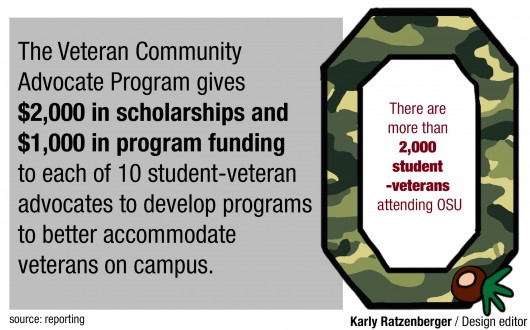Jeff Cheiky served six years in the U.S. Navy before enrolling at Ohio State, something he said can make it hard to connect to younger civilian students on campus.
“When I come to school here, as far as the social aspect, a lot of kids just want to party and drink all the time, and that party animal phase is already over for me,” Cheiky said.
At 28, Cheiky is now a fourth-year in aviation and said his life experiences sometimes make it difficult to relate to those students who came to college fresh out of high school.
As one of more than 2,000 veteran students on campus, Cheiky’s experience is far from unique.
Student-veterans are often wary of whether or not its appropriate to get involved in Greek Life and other student organizations, said Mike Carrell, director of OSU’s Office of Military and Veterans Services. He and others are working to step up the university’s approach in catering to veteran students.
“It’s really about understanding as a campus that we’re a different population than we were a few years ago and that this different campus population requires all of us to think differently so that we find a pathway for everyone to have a robust student experience,” he said.
That evolving landscape was part of the reason for the introduction of the Veteran Community Advocate Program this semester, which gives $2,000 in scholarships to each of 10 student-veteran advocates to develop programs to better accommodate veterans on campus, as well as an additional $1,000 in programmatic funding for each advocate, said Jim Miller, the senior associate vice president for OSU’s Office of Technology Commercialization and Knowledge Transfer.
The advocates are each assigned to a different campus office and works to develop programs that will better integrate veterans on campus.
The program is set to continue expanding next year, Miller said. Ten additional advocates have already committed and he expects a total of 30, with inclusion of the OSU’s branch campuses.
Ruth Nzimiro, a Navy veteran and a fourth-year in criminology, is a student-advocate and said student-veterans need to work on connecting with others more, whether those students be civilians or fellow veterans.
“In most of my classes, I noticed a kind of segregation of the civilian students and the military students,” Nzimiro said. “We have to learn how to mix a bit more.”
With the goal of helping student-veterans connect with others, Nzimiro has organized a dinner at the Ohio Union for veterans as well as their family and friends. She is also developing a survey for all student-veterans to take, which aims to gauge what concerns they have.
Carrell said student-veterans often have additional challenges because of the number of transitions they are making simultaneously.
As with traditional students, the transition into being a college student can be difficult enough, Carrell said, but veterans are also making the transition back to civilian life.
“You’re coming from an organization that values the mission and the team above everything else in every aspect of what you do,” Carrell said. “Now, you’re in college and you take care of everything yourself and it’s all about you. That’s hard.”
When Carrell first approached different offices about establishing affiliated advocate positions, most wanted the roles of advocates be laid out ahead of time. Carrell refused, though, and said it was important to give students as much freedom as possible.
“I’m a veteran and I think I might know what the concerns are but I could be completely wrong,” he said. “I’d much rather have the student and the office work out what they can do, so I refused to give them that. They didn’t like that, but the feedback we’re getting now is that they’re kind of glad because they are starting to tailor programs that really fit their offices, but more so, fit what the student needs are.”
Other programs developed by advocates include a four-year college planning guide for student veterans and a bootcamp-style fitness program to which aims to get student-veterans and civilian students to work out together.
Miller first proposed the program back in January as a way to honor his father, a career military man, and it developed from there.
After securing funding from donations, he and Carrell developed the program and selected student-advocates after an application and interview process by the end of Spring Semester.
While programs like these often take several years to roll out, Miller said the quick influx of student-veterans coming back from places like Iraq and Afghanistan necessitates an increase in resources.
“We have a burning platform,” he said. “We have so many veterans coming to campus. The numbers are exploding, and if we were to wait for a perfect plan, the problem will be all over us, so let’s just do it.”



